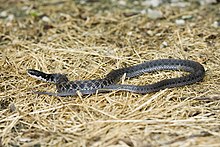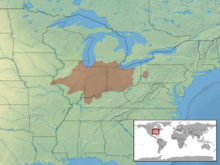Clonophis kirtlandii
| Kirtland's snake | |
|---|---|
 |
|
| Kirtland's snake, Clonophis kirtlandii | |
| Scientific classification | |
| Kingdom: | Animalia |
| Phylum: | Chordata |
| Class: | Reptilia |
| Order: | Squamata |
| Infraorder: | Serpentes |
| Family: | Colubridae |
| Genus: | Clonophis |
| Species: | C. kirtlandii |
| Binomial name | |
|
Clonophis kirtlandii (Kennicott, 1856) |
|
 |
|
| Synonyms | |
|
|
Kirtland's snake (Clonophis kirtlandii ) is an endangered North American species of nonvenomous snake of the subfamily Natricinae, of the family Colubridae. It is the only species in the genus Clonophis.
The specific name, kirtlandii, is in honor of Dr. Jared Potter Kirtland, an American naturalist of the Nineteenth Century. The snake was first identified by Robert Kennicott in 1855. Kennicott sent a specimen to Spencer Fullerton Baird, the assistant secretary of the Smithsonian Institution, who offered to publish a description of the animal in Kennicott's name. Baird suggested Regina kirtlandii as a scientific name, as Kirtland had been a mentor to Kennicott.
Common names for this species include: Cora Kennicott's snake, Kirtland's red snake, Kirtland's water snake, little red snake, Ohio Valley water snake, and spread head.
Kirtland's snake is small and slender. Adults reach a total length (body + tail) of 12-18 inches (30–46 cm). They are grayish brown with a series of large black spots and alternating smaller spots running down each side of the back. The ventral scales are brick red with a prominent round black spot at each outer end. It has 19 rows of keeled dorsal scales at midbody, and the anal plate is divided.
This species is found in Illinois, Indiana, Ohio, southern Michigan, northern Kentucky, and western Pennsylvania.
...
Wikipedia

